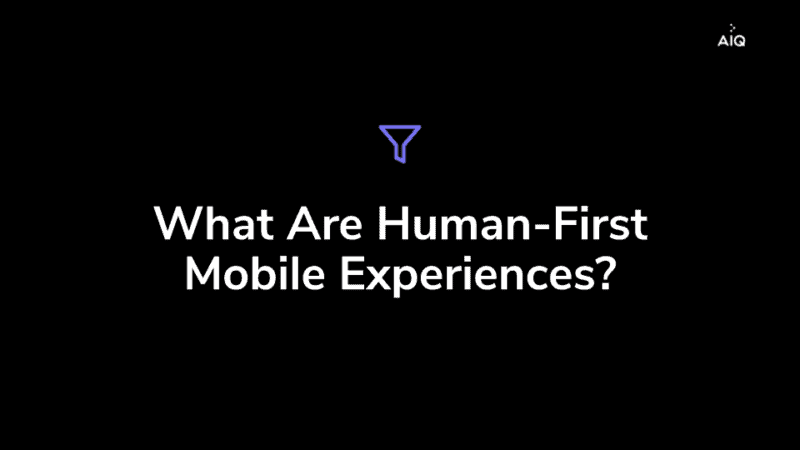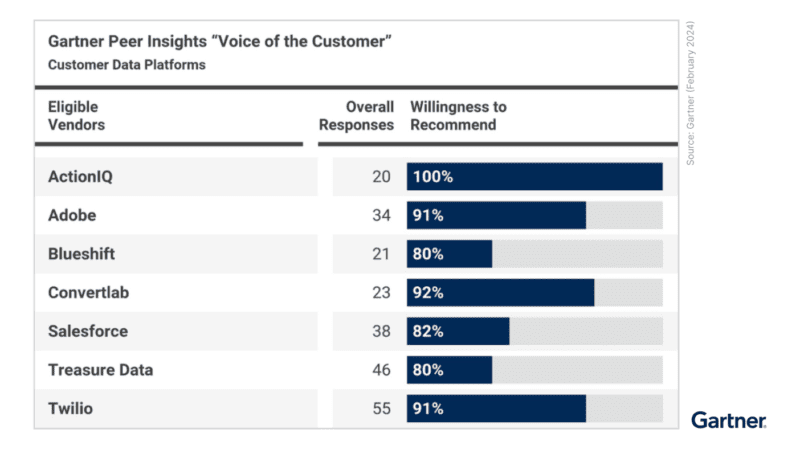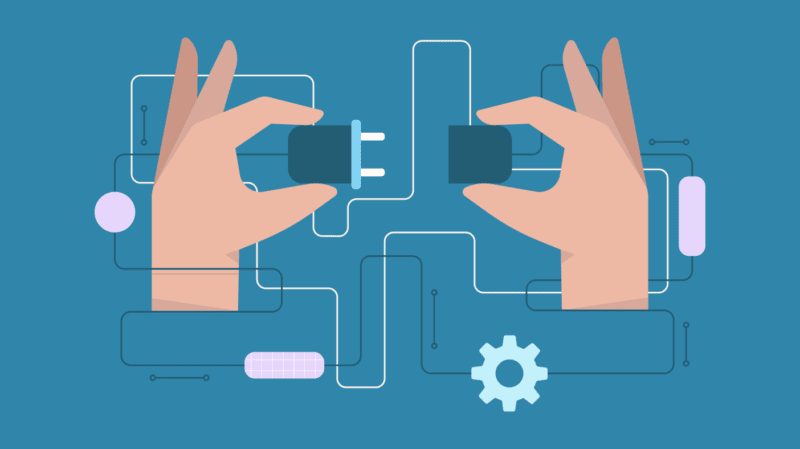What Are Human-First Mobile Experiences?

A human-first mobile experience turns traditional marketing processes on its head. Instead of designing apps and other experiences around the messages marketers want to push, human-first experiences are architected from the ground up around the needs and/or preferences of individual users—regardless of when, where, why and how they engage with your business.
Martin Chow, VP of consumer apps marketing at Google, is credited with inventing the term “human-first mobile experiences.”
The term may be recent, but the goal of human centered design is not. Long before the invention of the Internet, usability, customer satisfaction and customer-centric user experiences were essential to product designers. With the advent of the Internet, these goals were critical in the design process of websites, mobile apps, etc.
And so, the role of the UX designer was born. Over the years, the art of UX design has advanced dramatically, thanks to rigorous user research, usability testing, and a hyperfocus on user goals. Today, nearly every digital experience begins with the construction of wireframes that ensure that, at their core, mobile apps and other forms of digital engagement “think” like humans and meet human needs.
Now, the demand for usability, customer satisfaction and a customer-centric design process have crossed the barrier from the product design to marketing.
“With so much data today, it’s easy for marketers to become controlled by the numbers and slowly distanced from the human beings behind the data,” Chow told Adweek. “Data-driven insights are critical, but great marketing always pairs deep consumer empathy with a deep understanding of the lens your brand uniquely brings to storytelling.”
The concept of human-first user experiences grows out of a number of key digital-driven trends that have transformed not just mobile marketing but all kinds of human-digital interactions, including: 1) seamless connected experiences across channels; 2) authentic personalized experiences at scale; and 3) intuitive user interfaces that “think” like real humans.
However, the human-first paradigm goes one step further. Rather than exploiting these technologies to force their message onto consumers, human-first marketers harness these technologies to deliver helpful, pleasant and otherwise compelling experiences. When designing such experiences, consider some of the key principles of human-first interactions:
- Be of use. Offer what some refer to as “return on engagement.” That is, try to deliver content that enhances customers’ lives in some way, whether or not they make a purchase.
- Tell, don’t sell. Consumers are oversaturated with offers that try to sell them on some product or service. Increasingly, experiences that inform customers and then let them make their own choice are much more likely to break through.
- Sound human. Even when experiences are mobile and digital, consumers want the feeling that they are interacting with another unique, human voice. And they want that experience, regardless of the way they interact with your brand.
- Combine data with empathy. While data is invaluable in understanding the probability that consumers will behave in a certain way, it is vital to add empathy into the equation. That means understanding their hopes and fears—and the things that motivate them. By leading with this level of empathy, you can build trust while also differentiating your brand.
Why Human-First Mobile Experiences Are Important
Human-first mobile experiences are becoming a critical competitive differentiator in an age when consumers are bombarded by marketing. The average consumer sees somewhere between 4,000 and 10,000 messages a day, reports Forbes. In response to this onslaught, customers and prospects alike have hardened their cognitive and technological defenses. And that means they are more likely than ever to dismiss messages brands send them—even those offering something that offers a solution to their problems or that truly interests them.
In short, traditional marketing tactics are not working like they used to.
At the same time, the costs of traditional marketing have risen. For example, the price of digital advertising at premium brands like Google and Facebook has risen sharply. Yet ROI is harder than ever to achieve. One study found that brands must spend 42% more on ads to increase web traffic by 11%.
According to Chow and others, the human-first approach is the best way to reach today’s consumers. By focusing first on helping customers instead of selling to them, you have a better chance of gaining their attention. If you show them that you know who they are and understand their history with your brand—and their individual needs and preferences—you can win the trust necessary for them to continue investing their attention in the content you deliver.
And of course, you increase that trust when you speak to them with a single consistent voice, regardless of the channel with which they engage your brand. After all, the humans we know don’t act like three entirely different people when they speak to us in person, when we talk to them on the phone, and when we are messaging on Instagram.
In short, brands need to strive for consistency across all touch points. This not only leads to faster, more seamless transactions. It also increases confidence among customers that they will be treated like an individual during their user journey, not a faceless member of a demographic whose business the brand is trying to win.
How Customer Expectations Drive Demand for Human-First Experiences
Certain leading digital brands, from Amazon and Google to Netflix, have gone a long way toward implementing the human-first approach. In the process, they have increased the expectations for other brands to do the same. Brands that fail to implement a user centered experience face significant business risks.
A recent Salesforce study found that among 80% of customers, the experience a company provides is just as important as its products and services. And customers increasingly expect more from those experiences. For example, they expect consistent interactions across channels. They expect those interactions to be personalized. And they even expect empathy.
There is a gap, however, between expectations and reality. While the same Salesforce study found that 66% of customers expect companies to understand their unique needs and expectations, 66% feel they’re generally treated less like a real person and more like a number. While 76% expect consistency in their interactions across channels, Salesforce found, more than half (54%) said that they generally feel marketing, sales and service teams fail to share information.
Clearly, most brands need to get better at providing human-first, versus channel-first, experiences.
How to Provide Human-First Mobile Experiences
While the human-first experience is a straightforward concept, it requires a fundamental shift in: 1) the technologies you use to inform and activate customer experiences 2) the way marketing, sales and service departments are organized and incented, and 3) the principles that guide the creation of content and digital experiences generally.
Data activation via customer data platforms (CDPs) and/or related technologies
Customer data platforms (CDPs) and related technologies can provide an unprecedented 360-degree view of customers by gathering and organizing data from a wide variety of disparate systems. CDPs are helping brands across industries and of various sizes to play catch-up with the data and intelligence capabilities of digital-first giants like Amazon and others.
CDPs achieve this by speeding and automating the work that previously required large, highly skilled teams of database administrators, data scientists, and other data experts. What’s more, CDPs can instantly turn the insights fueled by all that data into connected, cross-channel customer journeys.
No matter the technology you use, human-first experiences begin with the ability to:
- Gather and organize all relevant customer data from as any source or system—including both first-party and third-party sources.
- Analyze that data to better predict the granular preferences and propensities of individual customers.
- Turn insights and data into action, on the fly. That means being able to build audiences based on any combination of customer attributes, and then deliver experiences to highly targeted audiences in an orchestrated way across every touch point, from websites and mobile apps to call centers and physical locations.
Organizational change from channel-first to user-first
Traditionally, marketing organizations have been divided into category-specific or channel-specific teams. With KPIs focused on boosting sales, loyalty and overall success of the individual channel, siloed teams have essentially been incented to speak in different voices to the same customer. And often these teams have resisted sharing their hard-won insights with their own colleagues. Understandably, they ask questions like, “Won’t your brick-and-mortar campaign cannibalize my digital sales?” Or, “why are you sending credit card offers to my home lending prospects?”
The problem is, these operational silos undermine the goals project of human-first experiences.
Instead, marketing leaders must ensure the organization is customer-centric, putting the customer first. That everyone in marketing, CX and beyond is aligned around providing superb end-to-end customer experiences that span all channels and touchpoints. Treating each consumer as an individual, not an email address or cookie. Achieving these goals requires a different kind of organization.
Organizational change is not easy. To make it happen, investing in technology isn’t enough. You also need:
- Executive sponsorship. Because human-first is a holistic approach, you need the whole organization to align to the new way of working, and that takes executive-level alignment, sponsorship, and commitment.
- New governance and accountability structures. In order to ensure cooperation across the organization, you must clearly document changing roles and responsibilities, reporting structures, and incentives.
Human-first content and UX that respect consumers’ time & attention
When it comes to the design of content, messaging, and user experiences that put humans first, brands have wide latitude in terms of how they design and execute.
That said, there are a number of principles that we have already touched on that help establish a strong foundation for human-first content.These include:
- Investing in user research, usability testing and ongoing customer feedback—and building them into the design process. This ensures that digital products and services are intuitive, and that they respond to real-world customer needs and pain points.
- Ensuring that you “tell”—engage users with content that is interesting or helpful—rather than “sell.” And speak with one voice, however and whenever you engage users.
But if we had to boil it down human-first marketing to a single concept, it would be this:
- Respect consumers’ time and attention.
Whatever offers you make and whatever voice you adopt, this respect is fundamental to marketing success in the experience economy.
Get Started on Your Human-First Customer Experience Strategy Today
ActionIQ and our industry leading CDP platform can help you design, plan and execute a human-first customer experience strategy that differentiates your brand, cements customer loyalty, and positively impacts revenue, retention, ROI and other marketing KPIs.
For a consultation with one of our customer data and customer experience experts, contact ActionIQ.





